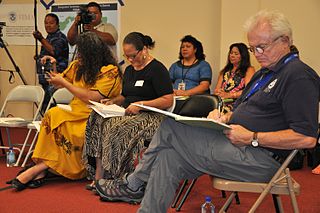Related Research Articles

Public relations (PR) is the practice of managing and disseminating information from an individual or an organization to the public in order to influence their perception. Public relations and publicity differ in that PR is controlled internally, whereas publicity is not controlled and contributed by external parties. Public relations may include an organization or individual gaining exposure to their audiences using topics of public interest and news items that do not require direct payment. The exposure is mostly media-based, and this differentiates it from advertising as a form of marketing communications. Public relations aims to create or obtain coverage for clients for free, also known as earned media, rather than paying for marketing or advertising also known as paid media. But in the early 21st century, advertising is also a part of broader PR activities.

In mass communication, digital media is any communication media that operates in conjunction with various encoded machine-readable data formats. Digital content can be created, viewed, distributed, modified, listened to, and preserved on a digital electronic device, including digital data storage media and digital broadcasting. Digital is defined as any data represented by a series of digits, and media refers to methods of broadcasting or communicating this information. Together, digital media refers to mediums of digitized information broadcast through a screen and/or a speaker. This also includes text, audio, video, and graphics that are transmitted over the internet for viewing or listening to on the internet.
Reputation management, originally a public relations term, refers to the influencing, controlling, enhancing, or concealing of an individual's or group's reputation. The growth of the internet and social media led to growth of reputation management companies, with search results as a core part of a client's reputation. Online reputation management, sometimes abbreviated as ORM, focuses on the management of product and service search engine results.
A media monitoring service, a press clipping service or a clipping service as known in earlier times, provides clients with copies of media content, which is of specific interest to them and subject to changing demand; what they provide may include documentation, content, analysis, or editorial opinion, specifically or widely. These services tend to specialize their coverage by subject, industry, size, geography, publication, journalist, or editor. The printed sources, which could be readily monitored, greatly expanded with the advent of telegraphy and submarine cables in the mid- to late-19th century; the various types of media now available proliferated in the 20th century, with the development of radio, television, the photocopier and the World Wide Web. Though media monitoring is generally used for capturing content or editorial opinion, it also may be used to capture advertising content.

Web 2.0 refers to websites that emphasize user-generated content, ease of use, participatory culture and interoperability for end users.
Mass communication is the process of imparting and exchanging information through mass media to large population segments. It utilizes various forms of media as technology has made the dissemination of information more efficient. Primary examples of platforms utilized and examined include journalism and advertising. Mass communication, unlike interpersonal communication and organizational communication, focuses on particular resources transmitting information to numerous receivers. The study of mass communication is chiefly concerned with how the content and information that is being mass communicated persuades or affects the behavior, attitude, opinion, or emotion of people receiving the information.

In computing, a news aggregator, also termed a feed aggregator, content aggregator, feed reader, news reader, or simply an aggregator, is client software or a web application that aggregates digital content such as online newspapers, blogs, podcasts, and video blogs (vlogs) in one location for easy viewing. The updates distributed may include journal tables of contents, podcasts, videos, and news items.
Web analytics is the measurement, collection, analysis, and reporting of web data to understand and optimize web usage. Web analytics is not just a process for measuring web traffic but can be used as a tool for business and market research and assess and improve website effectiveness. Web analytics applications can also help companies measure the results of traditional print or broadcast advertising campaigns. It can be used to estimate how traffic to a website changes after launching a new advertising campaign. Web analytics provides information about the number of visitors to a website and the number of page views, or create user behavior profiles. It helps gauge traffic and popularity trends, which is useful for market research.

User-generated content (UGC), alternatively known as user-created content (UCC), is generally any form of content, such as images, videos, text, testimonials, and audio, that has been posted by users on online content aggregation platforms such as social media, discussion forums and wikis. It is a product consumers create to disseminate information about online products or the firms that market them.

Social media are interactive technologies that facilitate the creation, sharing and aggregation of content, ideas, interests, and other forms of expression through virtual communities and networks. Social media refers to new forms of media that involve interactive participation. While challenges to the definition of social media arise due to the variety of stand-alone and built-in social media services currently available, there are some common features:
- Social media apps are online platforms that enable users to create and share content and participate in social networking.
- User-generated content—such as text posts or comments, digital photos or videos, and data generated through all online interactions—is the lifeblood of social media.
- Users create service-specific profiles for the website or app that are designed and maintained by the social media organization.
- Social media helps the development of online social networks by connecting a user's profile with those of other individuals or groups.
Social media optimization (SMO) is the use of a number of outlets and communities to generate publicity to increase the awareness of a product, service brand or event. Types of social media involved include RSS feeds, social news, bookmarking sites, and social networking sites such as Facebook, Instagram, Twitter, video sharing websites, and blogging sites. SMO is similar to search engine optimization (SEO) in that the goal is to generate web traffic and increase awareness for a website. SMO's focal point is on gaining organic links to social media content. In contrast, SEO's core is about reaching the top of the search engine hierarchy. In general, social media optimization refers to optimizing a website and its content to encourage more users to use and share links to the website across social media and networking sites.
Online identity management (OIM), also known as online image management, online personal branding, or personal reputation management (PRM), is a set of methods for generating a distinguished web presence of a person on the Internet. Online identity management also refers to identity exposure and identity disclosure, and has particularly developed in the management on online identity in social network services or online dating services.

A paywall is a method of restricting access to content, with a purchase or a paid subscription, especially news. Beginning in the mid-2010s, newspapers started implementing paywalls on their websites as a way to increase revenue after years of decline in paid print readership and advertising revenue, partly due to the use of ad blockers. In academics, research papers are often subject to a paywall and are available via academic libraries that subscribe.
Social media measurement, also called social media controlling, is the management practice of evaluating successful social media communications of brands, companies, or other organizations.

Social media marketing is the use of social media platforms and websites to promote a product or service. Although the terms e-marketing and digital marketing are still dominant in academia, social media marketing is becoming more popular for both practitioners and researchers. Most social media platforms have built-in data analytics tools, enabling companies to track the progress, success, and engagement of social media marketing campaigns. Companies address a range of stakeholders through social media marketing, including current and potential customers, current and potential employees, journalists, bloggers, and the general public. On a strategic level, social media marketing includes the management of a marketing campaign, governance, setting the scope and the establishment of a firm's desired social media "culture" and "tone".
In the online advertising industry, a viewable impression is a measure of whether a given advert was actually seen by a human being, as opposed to being out of view or served as the result of automated activity. The viewable impression guidelines are administered by the Media Rating Council and require that a minimum of 50% of the pixels in the advertisement were in an in-focus tab on the viewable space of the browser page for at least one continuous second.
Online presence management is the process of creating and promoting traffic to a personal or professional brand online. This process combines web design, and development, blogging, search engine optimization, pay-per-click marketing, reputation management, directory listings, social media, link sharing, and other avenues to create a long-term positive presence for a person, organization, or product in search engines and on the web in general.
Social media intelligence refers to the collective tools and solutions that allow organizations to analyze conversations, respond to synchronize social signals, and synthesize social data points into meaningful trends and analysis, based on the user's needs. Social media intelligence allows one to utilize intelligence gathering from social media sites, using both intrusive or non-intrusive means, from open and closed social networks. This type of intelligence gathering is one element of OSINT.
Social media use by businesses includes a range of applications. Although social media accessed via desktop computers offer a variety of opportunities for companies in a wide range of business sectors, mobile social media, which users can access when they are "on the go" via tablet computers or smartphones, benefit companies because of the location- and time-sensitive awareness of their users. Mobile social media tools can be used for marketing research, communication, sales promotions/discounts, informal employee learning/organizational development, relationship development/loyalty programs, and e-commerce.

Stuck: How Vaccine Rumors Start and Why They Don't Go Away (2020), published by Oxford University Press and written by the director of the London School of Hygiene and Tropical Medicine's Vaccine Confidence Project, Heidi Larson, looks at what influences attitudes to vaccination. It was largely compiled before the COVID-19 pandemic and inspired by her feeling that the dialogue between scientists and the public regarding vaccines was becoming complex on a background of increasing online information.
References
- ↑ Miranda, Sebastião. "Tailoring Media Monitoring with User Feedback." Text2Story@ ECIR. 2020.
- ↑ "Media Monitoring | The SAGE Glossary of the Social and Behavioral Sciences - Credo Reference". search.credoreference.com. Retrieved March 26, 2022.
- ↑ Kirby, Justin; Marsden, Paul (June 7, 2007). Connected Marketing. Routledge. ISBN 978-1-136-41565-4.
- ↑ Batrinca, Bogdan; Treleaven, Philip C. (February 1, 2015). "Social media analytics: a survey of techniques, tools and platforms". AI & Society. 30 (1): 89–116. doi: 10.1007/s00146-014-0549-4 . ISSN 1435-5655. S2CID 12574246.
- ↑ Töllinen, Aarne; Järvinen, Joel; Karjaluoto, Heikki (2012). "Social Media Monitoring in the industrial Business to Business Sector". World Journal of Social Sciences.
- ↑ I. Flaounas, M. Turchi, T. De Bie, and N. Cristianini, "Inference and Validation of Networks", ECML/PKDD, Bled, Slovenia, Springer, pp. 344–358, 2009.
- ↑ N. Godbole,M. Srinivasaiah, S. Skiena, "Large-Scale Sentiment Analysis for News and Blogs", Int. Conf. on Weblogs and Social Media (ICWSM 2007), Denver CO, March 26–28, 2007
- ↑ Karafillakis, Emilie; Martin, Sam; Simas, Clarissa; Olsson, Kate; Takacs, Judit; Dada, Sara; Larson, Heidi Jane (February 8, 2021). "Methods for Social Media Monitoring Related to Vaccination: Systematic Scoping Review". JMIR Public Health and Surveillance. 7 (2): e17149. doi: 10.2196/17149 . ISSN 2369-2960. PMC 7899807 . PMID 33555267.